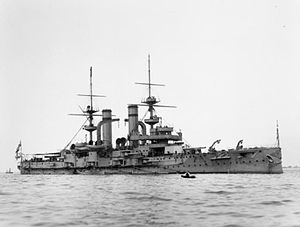HMS Triumph (1903)

HMS Triumph
|
|
| History | |
|---|---|
|
|
|
| Name: | Libertad |
| Ordered: | 1901 |
| Builder: | Vickers, Sons & Maxim, Barrow-in-Furness |
| Laid down: | 26 February 1902 |
| Launched: | 15 January 1903 |
| Renamed: | HMS Triumph |
| Fate: | Sold to the United Kingdom, 3 December 1903 |
|
|
|
| Name: | HMS Triumph |
| Cost: | £957,520 |
| Completed: | June 1904 |
| Acquired: | 3 December 1903 |
| Commissioned: | 21 June 1904 |
| Fate: | Torpedoed and sunk by U-21, 25 May 1915 |
| General characteristics | |
| Class and type: | Swiftsure-class pre-dreadnought battleship |
| Displacement: |
|
| Length: | 475 ft 3 in (144.9 m) (o/a) |
| Beam: | 71 ft 1 in (21.7 m) |
| Draught: | 27 ft 4 in (8.3 m) (deep) |
| Installed power: | 12,500 ihp (9,300 kW) |
| Propulsion: |
|
| Speed: | 19 knots (35 km/h; 22 mph) |
| Range: | 6,210 nmi (11,500 km; 7,150 mi) at 10 knots (19 km/h; 12 mph) |
| Crew: | 803 (1914) |
| Armament: |
|
| Armour: | |
HMS Triumph, originally known as Libertad, was the second of the two Swiftsure-class pre-dreadnought battleships of the Royal Navy. The ship was ordered by the Chilean Navy, but she was purchased by the United Kingdom as part of ending the Argentine–Chilean naval arms race. Triumph was initially assigned to the Home Fleet and Channel Fleets before being transferred to the Mediterranean Fleet in 1909. The ship briefly rejoined the Home Fleet in 1912 before she was transferred abroad to the China Station in 1913. Triumph participated in the hunt for the German East Asia Squadron of Maximilian Graf von Spee and in the campaign against the German colony at Tsingtao, China early in World War I. The ship was transferred to the Mediterranean in early 1915 to participate in the Dardanelles Campaign against the Ottoman Empire. She was torpedoed and sunk off Gaba Tepe by the German submarine U-21 on 25 May 1915.
Triumph was ordered by Chile, with the name of Libertad, in response to the Argentine purchase of two armoured cruisers from Italy during a time of heightened tensions with Argentina. After the crisis subsided, financial problems forced Chile to put the ship up for sale in early 1903; concerned that Russia might buy them, the United Kingdom stepped in and with financing via merchant bank Antony Gibbs & Sons purchased the still-incomplete ships from Chile on 3 December 1903 for £2,432,000. The ship was designed to Chilean specifications, particularly the requirement to fit in the graving dock at Talcahuano, and was regarded by the British as a second-class battleship.
...
Wikipedia
